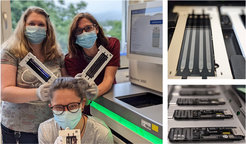
Next Generation Sequencing Technology
Short-read sequencing (Illumina Technology)
- analyses sequences from 0.2-0.8 kb
- library preparation: nucleic acids are fragmented, if needed converted into DNA and ligated to specific sequencing adapters (Libraries).
- Sequencing: Libraries are bound to oligonucleotides that code the surface of a flowcell. For signal amplification each library fragment is millions of times amplified and forms a “cluster”. After cluster generation the sequencing process begins. During Sequencing by synthesis fluorescently labelled deoxynucleoside triphosphates are incorporated into the newly synthesized DNA strand at each cycle. After incorporation, a laser excites the fluorophore on the strand, which emits a characteristic fluorescence signal that corresponds to the base8.
- Instaled instruments: NovaSeq (capacity 400-2500 million fragments), NextSeq (400 million fragments), MiSeq (25 million fragments). Choice of instrument depends on the experimental need and on internal sample logistics.
Long- read sequencing (Oxford Nanopore Technology)
- read lengths is limited by the molecule lengths in the sample. ONT data can be considered “standard long read” (10-100kb) and “ultra-long read” (greater than 100kb).
- Library preparation: nucleic acids (DNA or RNA) are ligated to sequencing adapters, coupled to a motor protein. The motor protein helps to drag the DNA/RNA molecule to the nanopore.
- Sequencing: ONT libraries are loaded onto a flowcell, consisting of thousands of nanopores embedded into a membrane. The motor protein unwinds the double stranded DNA and drives the DNA, together with the electric current, through the pore. Upon DNA translocation changes in current are registered and can be translated into a DNA sequence. In a similar manner epigenetic modifications can be registered (DNA methylation patterns)
- Installed instruments: GridION (ONT), up tp 250Gb per run

Sequencing Technology. Left: NovaSeq instrument. Top Right: Flowcell for short-read sequencing (NovaSeq). Bottom Right: Flowcell for long-read sequencing (GridION)
